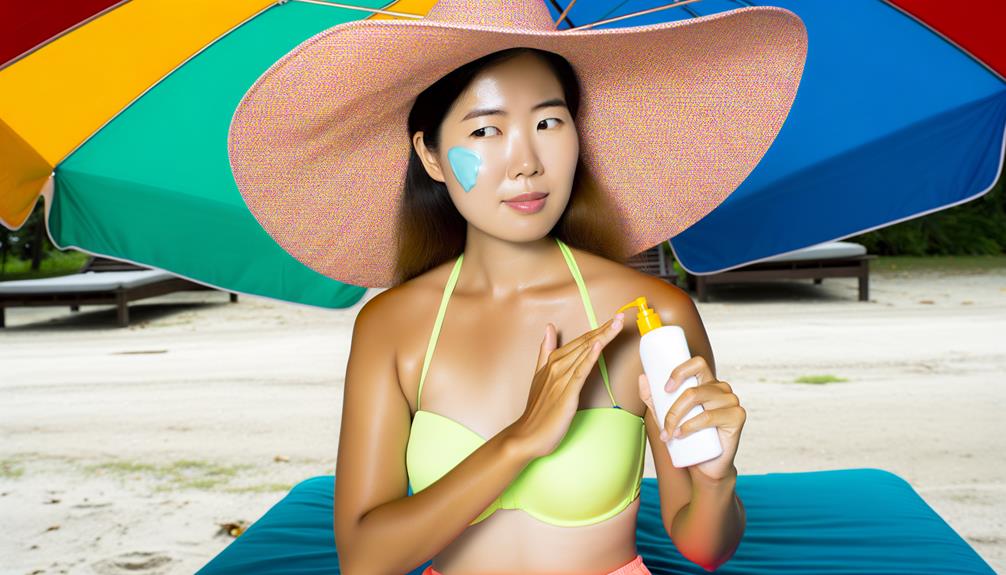
As we venture into the warmer months, the desire for a sun-kissed glow becomes increasingly prevalent. However, achieving a proper tan necessitates a thoughtful and informed approach. From understanding the different methods of tanning to implementing best practices for skin protection, there is a wealth of information to consider.
In this discussion, we will explore the key strategies for obtaining a healthy and natural tan, while prioritizing skin safety and long-term well-being. By delving into the nuances of outdoor sun exposure, tanning beds, self-tanners, and spray tans, individuals can make informed decisions and adopt a balanced approach to tanning.
Key Takeaways
- Gradually increase sun exposure or tanning bed sessions to avoid sunburn and overexposure.
- Use sunscreen with SPF 30 or higher to protect your skin from harmful UV rays.
- Exfoliate regularly and moisturize your skin to maintain a healthy and even tan.
- Consider alternatives like self-tanners or spray tans for a tan without sun exposure.
Outdoor Tanning Tips
To achieve a proper tan through outdoor tanning, it is essential to gradually increase sun exposure and incorporate proper skin care practices to ensure a safe and effective tanning experience.
When laying out in the sun, it's important to know how long should you tan on each side. Begin with short exposure periods, around 10-15 minutes, and gradually increase by 5 minutes each session. This helps to avoid sunburn and allows you to pay attention to your skin's reaction, adjusting the time accordingly.
To get an even tan, consider rotating every 15-30 minutes to ensure all sides are evenly exposed. Don't forget to tan your chest in the sun by lying on your back and then your stomach, allowing each side to receive equal sun exposure.
It's crucial to use sunscreen with SPF 15-45 before sun exposure to protect your skin. Reapply every two hours, especially after swimming or sweating, and avoid peak hours when the sun is strongest, typically between 10 am and 4 pm.
Tanning Bed Guidelines
When using a tanning bed, it is important to adhere to recommended exposure times and gradually increase them to achieve a proper tan while minimizing the risk of skin damage. Follow these guidelines for a safe and effective tanning bed experience:
- Adhere to recommended exposure times: Start with short sessions, such as 3-5 minutes, and gradually increase the time. Pay attention to your skin's response and adjust accordingly.
- Use a tanning bed lotion: Apply a tanning bed lotion to enhance your tan and protect your skin from potential damage.
- Wear protective eyewear: Shield your eyes from UV rays by wearing protective eyewear during tanning bed sessions.
- Limit tanning bed sessions: Avoid overexposure by adhering to the recommended tanning intervals and limiting the frequency of tanning bed sessions.
Following these guidelines will help you achieve a healthy tan while reducing the risk of skin damage.
Remember to moisturize your skin regularly to maintain its health and prevent dryness, both during and after tanning bed sessions.
Self-Tanner Application
When thinking about achieving a healthy tan while minimizing the risk of skin damage, the application of self-tanner becomes an important consideration.
To get a natural-looking tan without sun exposure, self-tanners are a popular choice. Start by exfoliating your skin to ensure an even application and prevent patchiness. Apply the self-tanner in a circular motion, blending it well into your skin, and use a tanning mitt or gloves to avoid staining your hands. Allow the self-tanner to dry completely before dressing to prevent smudging.
Additionally, moisturize daily to maintain your self-tan and prolong its longevity. Self-tanners provide a safe alternative to getting a tan at the beach or using tanning beds, allowing you to achieve a nice, natural tan without the risk of sun damage. By following these steps, you can achieve the perfect tan without sun exposure and increase tanning without compromising the health of your skin.
It's also important to protect your eyes while tanning outside by wearing sunglasses that provide UV protection.
Spray Tan Recommendations
Adequate preparation and aftercare are essential for achieving an optimal and long-lasting spray tan.
When considering spray tan recommendations, here are some vital tips to keep in mind:
- Exfoliate your skin before getting a spray tan to ensure an even result.
- Follow the instructions provided by the spray tan technician for the best outcome.
- Wear loose-fitting clothing after your spray tan to avoid smudging.
- Avoid showering or sweating for the recommended time after your spray tan.
General Tanning Tips and Warnings

To ensure a safe and effective tanning experience, it is essential to adhere to general tanning tips and warnings, particularly after receiving a spray tan.
When tanning outside, it's crucial to know how to sun tan safely. Start by finding the right tanning positions to ensure an even tan and reduce the risk of sunburn. Gradually increase your time in the sun, beginning with short periods and gradually building up to avoid overexposure.
Use good tanning methods, such as applying sunscreen with SPF 15-45 before sun exposure and reapplying after swimming or sweating. Additionally, wear protective clothing and consider using wide-brimmed hats for added sun protection.
It's important to avoid peak hours when the sun is strongest, typically between 10 am and 4 pm, and stay hydrated by drinking plenty of water. After tanning, take cool showers, moisturize, and regularly check your skin for any changes.
Frequently Asked Questions
Can I Use Sunscreen With a Higher SPF for Better Protection While Tanning Outdoors?
Yes, using sunscreen with a higher SPF provides better protection while tanning outdoors. It helps prevent sunburn, skin cancer, and premature aging by blocking harmful UV rays. The American Academy of Dermatology recommends using SPF 30 or higher.
How Can I Prevent Tan Lines When Tanning in a Swimsuit?
To prevent tan lines when tanning in a swimsuit, consider using a strapless bikini or rotating the straps to minimize lines. Adjust swimwear periodically and change positions regularly to ensure an even tan.
Is It Safe to Use Tanning Oils to Enhance My Tan While Tanning Outdoors?
Yes, using tanning oils to enhance your tan while tanning outdoors can be safe if done with caution. Choose oils with SPF protection and reapply regularly. It's crucial to follow sun safety guidelines to minimize the risk of skin damage and burns.
What Are the Best Ways to Soothe Sunburned Skin After Tanning?
After tanning, soothe sunburned skin by applying aloe vera gel or a gentle moisturizer. Take cool showers, wear loose clothing, and drink plenty of water to hydrate the skin. Avoid further sun exposure and consult a dermatologist if needed.
Are There Any Specific Foods or Supplements That Can Help Improve My Skin's Ability to Tan?
There is no specific food or supplement that can significantly improve the skin's ability to tan. While a balanced diet rich in vitamins and nutrients can support overall skin health, the primary factors in tanning are sun exposure and melanin production.




